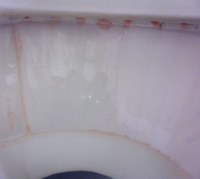Red Substance in Tub, Toilet is Bacteria
(Click the image below to view a high-resolution image that can be downloaded)
If you’ve noticed a pink or red slimy substance forming in your toilet bowl, you’re not alone.
It is bacteria known as Serratia marcescens, according to Roxanne Johnson, North Dakota State University Extension Service water quality associate.
You may find this bacterium in moist areas such as toilet bowls, sinks, tiles, shower stalls, bathtub enclosures and even your pet’s water dish. The bacteria will grow in places with materials containing phosphorus or fatty substances such as feces residues in your toilet or soap residue in a pet’s dish or the bathtub, shower and sink.
Occasionally the pinkish film appears during and after new construction or remodeling activities. You see it more commonly when you have your windows open during the summer months.
“I have observed this phenomenon form in the toilet bowl along the water line and at the openings where the water enters the toilet bowl, usually when I’m gone for a few days, or in my guest bathroom that isn’t used often,” Johnson says.
“The bacteria survive there because the water sits for a period of time, with the chlorine dissipating as it stands,” she adds. “If you have an activated carbon filter on your water line, you are removing the chlorine and may be supporting the growth of the bacteria.”
While the genus Serratia is not known to be a water-borne disease, it has been known to be pathogenic to some people, causing pneumonia, wound infections and urinary tract infections in some hospital settings.
The bacteria are difficult to remove completely from your home, although the stains are removed easily with a general-purpose cleanser containing chlorine bleach. You also may add ¼ cup of bleach to the toilet tank, let it sit for 15 to 20 minutes and then flush the tank a few times to remove all of the bleach. Do not leave bleach sitting in your tank because it will damage rubber valves and seals.
Johnson recommends you scrub with a brush and household cleaner to clean pet bowls, kitchen surfaces and bathroom sinks, bathtubs and showers. Follow this up with a strong chlorine bleach solution, leaving the bleach in contact with the surfaces for 10 to 20 minutes to disinfect the area. Then rinse well with water.
To prevent the bacteria from developing, wipe down and dry all sinks and bathtubs after using them, and use a cleaning solution that contains bleach.
NDSU Agriculture Communication
| Source: | Roxanne Johnson, (701) 231-8926, roxanne.m.johnson@ndsu.edu |
|---|---|
| Editor: | Ellen Crawford, (701) 231-5391, ellen.crawford@ndsu.edu |


